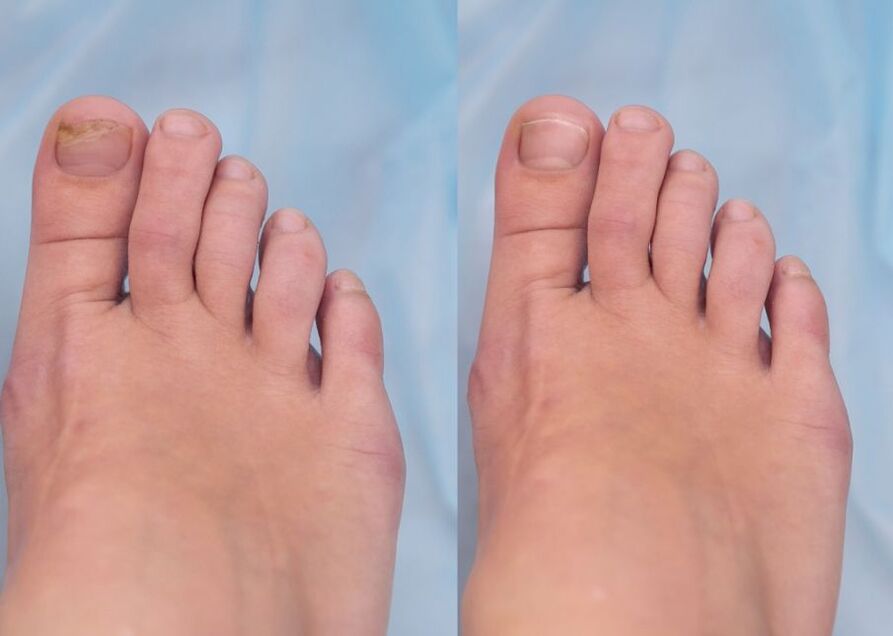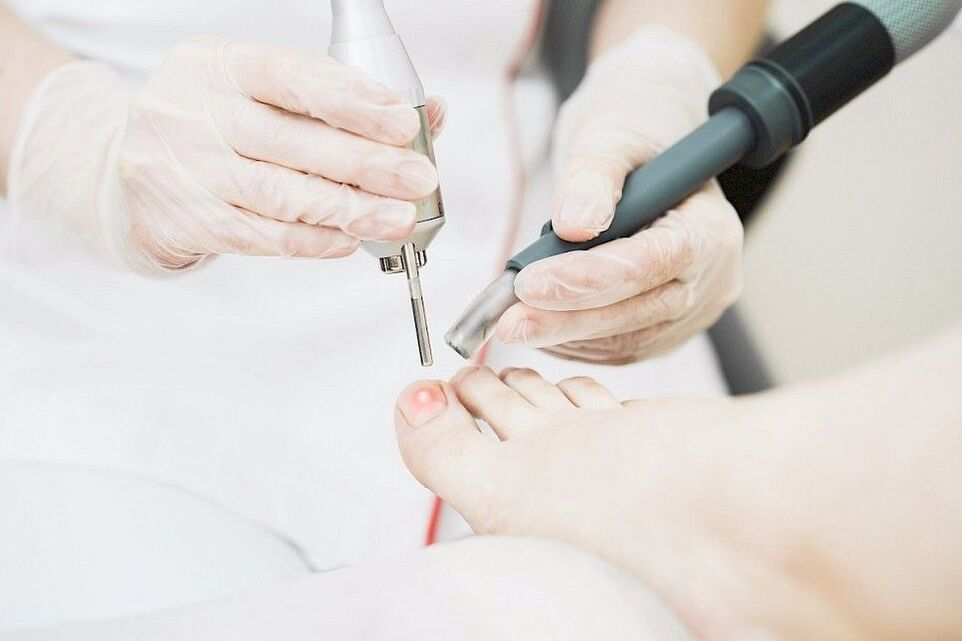Fungus spoils the appearance of nails and makes us embarrassed if someone notices it. However, it can be difficult to get rid of it. After taking medications and ointments, the disease may return again along with discomfort, itching and burning. It is important to choose a remedy that would completely eliminate the disease.
In this article we will figure out how to treat nail fungus so that it does not return.
Signs of nail fungus
The medical name for nail fungus is onychomycosis. Like many diseases, it does not manifest itself sharply and clearly immediately after infection. The first signs appear 2-3 weeks after exposure to the pathogen. First, the nail plate loses its glossy shine, then other symptoms appear:
- whitish or yellowish stripes, spots on the nail plate;
- change in nail color to yellow, brown or gray;
- thickening, detachment, tuberosity of the nail plate;
- unpleasant odor;
- peeling and redness of the skin around the nail and between the fingers;
- burning and itching.
Without treatment, a fungal infection completely destroys the nail plate: it peels off and exposes the nail bed.
Where can you get this disease?
Public places with high humidity pose a danger: swimming pools, baths, hammams, saunas, gyms. The fungus is easily transmitted through direct contact with an infected person: the pathogen enters healthy areas and causes an infection. You can become infected if you use the patient’s personal belongings, for example, his shoes or towel.
The fungus also spreads in places where there are shoe rentals. For example, in bowling or rental of skates, ski shoes, snowboards. It is especially dangerous if sanitary standards are not observed there. You can become infected with onychomycosis from slippers if they are often worn by different guests.
Beauty salons and manicurists and pedicurists who provide services at home also pose a danger. But only if they do not use disposable materials for each new client or do not sterilize work tools.
What does fungus look like on nails?
An example of nail fungus in the photo is clearly shown. The main signs of onychomycosis are immediately visible: changes in the color of the nail, its thickening, and lumpiness. On the left is a nail before treatment, on the right after laser treatment.

Stages of disease development
The disease develops gradually. Immediately after infection you will not experience discomfort, the appearance of the nail will hardly change. But over time, the number of unpleasant symptoms increases. Nail fungus has 3 stages:
- normotrophic - stripes of yellowish and whitish color appear in the thickness of the nail, but its shape and thickness do not change, there is no subungual hyperkeratosis, that is, thickening and detachment;
- hypertrophic - the nail plate acquires a yellow, gray or brown tint, the nail thickens due to hyperkeratosis, fragility appears, the edges become jagged;
- dystrophic - the nail becomes thinner and peels off from the nail bed, voids form.
Why is fungus dangerous?
You should consult a doctor as soon as you notice the first changes in the nail. The disease does not go away on its own; without treatment it will spread to other parts of the body and progress.
If you start the disease, there is a risk of complications:
- the addition of another infection, for example, erysipelas - this is an infectious-allergic disease that appears on the skin as red spots;
- diabetic foot with trophic ulcers on the legs, in severe cases this leads to gangrene;
- allergic rashes and peeling on the skin;
- in rare cases, damage to internal organs and systems.
Nail fungus is not only an external defect, so self-medication can cause serious harm. You should not take medications without a prescription from a specialist, as they can have side effects or have an unpredictable effect on the body.
There are many types of fungi that cause the disease. To find tablets and ointments that will work in your case, you need to undergo laboratory testing. Otherwise, the medicine may be useless.
Which doctor treats fungus?
Diseases of the skin and nails are treated by a dermatologist or dermatovenereologist, he carries out diagnostics and prepares treatment. But there is a highly specialized dermatologist who deals exclusively with fungal infections - a mycologist.
The professional clinic employs experienced dermatologists; they take a comprehensive approach to the treatment of onychomycosis. At the first stage, specialists examine the affected nails. Then laboratory diagnostics are carried out - it allows you to confirm the diagnosis and determine the type of fungus. After this, the doctor draws up a treatment plan, taking into account the patient’s contraindications and his wishes.
The modern clinic also employs podologists—masters who prepare nails for further treatment and perform medical pedicures. This is not the same procedure that is done in beauty salons. To understand the difference, you need to consider the types of pedicure:
- medical pedicure is the treatment of problem nails for more effective treatment, during the process the specialist removes the damaged layer of the nail, as a result, anti-fungal agents act deeper;
- A therapeutic pedicure is a procedure that helps solve problems with skin and nails; during the process, the master can use ointments, preparations, lotions, etc. for healing and treatment of problem areas;
- aesthetic pedicure - this is done in beauty salons, it makes the foot and nails more aesthetically attractive.
A dermatologist and a podologist are specialists who work together so that the patient can get rid of the fungal disease as quickly as possible.

Methods for eliminating fungus
Modern medicine offers several treatment options for onychomycosis. Let's consider each method separately.
Medications
Pharmacies sell many tablets, ointments and varnishes against onychomycosis; they are called antimycotics. But you cannot buy any drug and get rid of the disease, because different drugs are directed against different types of fungus. Moreover, antifungal drugs are toxic, so the correct dosage must be observed.
Another important nuance: the fungus is immune to the drug. If this is not the first time you have taken medication, the causative agent of the disease may develop immunity, so treatment will be useless.
Special plasters
They are glued to the damaged nail, and the active ingredients in the composition fight the problem. But the product only works superficially; the patch will not help get rid of the fungus inside the nail and skin.
In addition, it is not always convenient to walk with it: it can fall off when walking or come off due to humidity. And if more than one nail is affected, then applying a patch to each finger is not very convenient.
Laser therapy
This is the most effective modern treatment method. The laser shows visible results from the first use in 90% of cases. There is no pain, burning or discomfort during the process, and one treatment lasts only about 10 minutes.
Treatment takes place in 2 stages:
- The laser acts deeply on the mycelium of the fungus to destroy it. At the same time, healthy skin and nail tissues are not damaged.
- The laser restores the nail plate, causing it to grow back faster.
Ointments, tablets and patches do not give such a deep and quick effect.
The laser allows you to avoid removing the nail and keep the plate healthy.
Prevention measures
To avoid having to treat nail fungus, you should follow preventive measures. Simple rules will help protect against the disease:
- maintain personal hygiene - shower regularly, wear clean socks, trim your nails once a week;
- if you go to a public bath, sauna, swimming pool, use only individual slippers and a towel;
- do not walk barefoot in public places;
- do not wear someone else’s shoes, even house slippers, when visiting;
- do not walk in wet shoes;
- strengthen your immune system and maintain your health.
When going for a manicure and pedicure, do not hesitate to ask the master how he processes and sterilizes working accessories.
Why is it better not to self-medicate, but to turn to professionals?
In the best case, after self-medication, the fungus will reappear on the nails; in the worst case, using medications without the supervision of a doctor will harm your health. Only a doctor can select a comprehensive treatment and completely get rid of the problem.
At the clinic, a dermatologist will conduct diagnostics and necessary studies. Then the podiatrist will process and prepare the nail plate. The main part of the treatment is carried out using a laser - specialists use modern innovative equipment. You will notice improvements after the first procedure.
To make the treatment easy and the procedures pleasant, specialists treat each patient with care and warmth, and doctors select an individual approach.


























